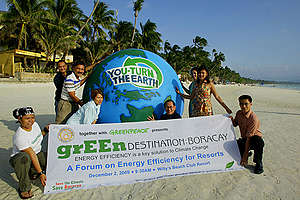
DOT is rolling out its “GrEEn Destinations” project with Greenpeace,in Boracay and eventually to other destinations next year. Turnover ceremonies were held during the Energy Efficiency workshop for resort operators, in Boracay. The symbolic turnover of the globe represented both the turning of the Earth from climate change, as well as the turnover and spread of Energy Efficiency measures among tourist destinations. Leading the ceremonies were: Mark Dia, Greenpeace Southeast Asia Deputy Campaign Director; Atty. Lucas Nunag, Bohol Provincial Tourism Council Head; Atty. Ma. Victoria Jasmin, DOT Director for Tourism Standards; Arch. Mike Guerrero of the Green Architecture Advocacy of the Philippines; Beng Reyes Ong, Greenpeace Energy Efficiency Campaigner; and Loubelle Cann, Boracay Foundation President.
This year Greenpeace Southeast Asia is celebrating our tenth year as an office in the region. But did you know that we were already working here well before the year 2000? Mark Dia, Philippines Country Representative, is possibly one of the very first volunteers from Southeast Asia. Here’s his story.
Seventeen years ago, I had the privilege of getting on board one of our vessels called the MV Greenpeace, a well loved ship that we retired many years back. I was keen to get onboard because I saw a video clip of Greenpeace to prevent the dumping of radioactive wastes out in the high seas of Japan. They were very successful and I found that really inspiring. I was already involved in environmental work and I thought this was something I really wanted to do.
Back in 1994, countries were meeting about the Basel Convention, an international agreement meant to stop rich countries from sending their toxic waste to poor countries. This was unfortunately the practice during that time, and some industrialized nations wanted to keep it that way.
I joined a group of volunteers, and we investigated how and where rich countries dump their trash in countries in Southeast Asia, including the Philippines. Following strict safety procedures, we collected the toxic waste as evidence. The highlight of our work was when we delivered all the toxic evidence to Switzerland, where the Basel Convention was being held, and showed world leaders why they needed to ratify the convention.
When we went to the Philippines, we intercepted a Russian ship, GAMZAT TSADASA containing toxic waste from Australia. We had information that the toxic waste shipment would be sold to the Philippines in the guise of raw materials. We anchored the MV Greenpeace out in the harbour in Manila and in the middle of the night one of our volunteers stopped the container ship from moving by climbing the anchor chain.
I was with another group of volunteers and we climbed the crane of the ship with a banner that said “Australia Stop Wasting Asia.” The crane was unloading the toxic waste, and the banner – we use a lot of banners in Greenpeace – was meant to announce and expose what the ship was doing. Otherwise no one would know.
That sort of “Greenpeace action” – peaceful yet powerful – was a new experience for all of us volunteers. But it made us think about what we can do and how we can help change things. Our protest caught the attention of policy makers and that was our objective: to expose what was happening and make sure that the government enacts safeguards to make sure it doesn’t happen again.
The thing that really struck me being a volunteer for Greenpeace was taking action — when you highlight what the problems are and point to the institutions of the leaders who can make a decision. Citizen action is a very powerful tool. I also realized that being courageous, passionate, creative and being ready to take risks really does create change for the better. It was a life-changing experience for me.
Mark Dia first started as a volunteer for Greenpeace before becoming the Philippine Country Representative at Greenpeace Southeast Asia

